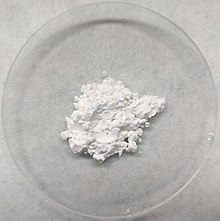
Back Aluminiumoksied Afrikaans أكسيد الألومنيوم Arabic Alúmina AST Alüminium oksid Azerbaijani آلومینیوم اوکسید AZB Алуминиев оксид Bulgarian অ্যালুমিনিয়াম অক্সাইড Bengali/Bangla Aluminij-oksid BS Òxid d'alumini Catalan Oxid hlinitý Czech

| |

| |
| Names | |
|---|---|
| IUPAC name
Aluminium oxide
| |
| Systematic IUPAC name
Aluminium(III) oxide | |
| Other names
Dialuminium trioxide
| |
| Identifiers | |
3D model (JSmol)
|
|
| ChEMBL | |
| ChemSpider | |
| DrugBank | |
| ECHA InfoCard | 100.014.265 |
| EC Number |
|
PubChem CID
|
|
| RTECS number |
|
| UNII | |
CompTox Dashboard (EPA)
|
|
| |
| |
| Properties | |
| Al2O3 | |
| Molar mass | 101.960 g·mol−1 |
| Appearance | white solid |
| Odor | odorless |
| Density | 3.987 g/cm3 |
| Melting point | 2,072 °C (3,762 °F; 2,345 K)[3] |
| Boiling point | 2,977 °C (5,391 °F; 3,250 K)[4] |
| insoluble | |
| Solubility | insoluble in all solvents |
| log P | 0.31860[1] |
| −37.0×10−6 cm3/mol | |
| Thermal conductivity | 30 W·m−1·K−1[2] |
Refractive index (nD)
|
nω = 1.768–1.772 nε = 1.760–1.763 Birefringence 0.008 |
| Structure | |
| Trigonal, hR30 | |
| R3c (No. 167) | |
a = 478.5 pm, c = 1299.1 pm
| |
| octahedral | |
| Thermochemistry | |
Std molar
entropy (S⦵298) |
50.92 J·mol−1·K−1[5] |
Std enthalpy of
formation (ΔfH⦵298) |
−1675.7 kJ/mol[5] |
| Pharmacology | |
| D10AX04 (WHO) | |
| Hazards | |
| GHS labelling: | |

| |
| NFPA 704 (fire diamond) | |
| Flash point | Non-flammable |
| NIOSH (US health exposure limits): | |
PEL (Permissible)
|
OSHA 15 mg/m3 (total dust) OSHA 5 mg/m3 (respirable fraction) ACGIH/TLV 10 mg/m3 |
REL (Recommended)
|
none[6] |
IDLH (Immediate danger)
|
N.D.[6] |
| Related compounds | |
Other anions
|
aluminium hydroxide aluminium sulfide aluminium selenide |
Other cations
|
boron trioxide gallium(III) oxide indium oxide thallium(III) oxide |
| Supplementary data page | |
| Aluminium oxide (data page) | |
Except where otherwise noted, data are given for materials in their standard state (at 25 °C [77 °F], 100 kPa).
| |
Aluminium oxide (or aluminium(III) oxide) is a chemical compound of aluminium and oxygen with the chemical formula Al2O3. It is the most commonly occurring of several aluminium oxides, and specifically identified as aluminium oxide. It is commonly called alumina and may also be called aloxide, aloxite, or alundum in various forms and applications. It occurs naturally in its crystalline polymorphic phase α-Al2O3 as the mineral corundum, varieties of which form the precious gemstones ruby and sapphire. Al2O3 is significant in its use to produce aluminium metal, as an abrasive owing to its hardness, and as a refractory material owing to its high melting point.[7]
- ^ "Aluminum oxide_msds".
- ^ Cite error: The named reference
propertieswas invoked but never defined (see the help page). - ^ Patnaik, P. (2002). Handbook of Inorganic Chemicals. McGraw-Hill. ISBN 978-0-07-049439-8.
- ^ Raymond C. Rowe; Paul J. Sheskey; Marian E. Quinn (2009). "Adipic acid". Handbook of Pharmaceutical Excipients. Pharmaceutical Press. pp. 11–12. ISBN 978-0-85369-792-3.
- ^ a b Zumdahl, Steven S. (2009). Chemical Principles 6th Ed. Houghton Mifflin Company. ISBN 978-0-618-94690-7.
- ^ a b NIOSH Pocket Guide to Chemical Hazards. "#0021". National Institute for Occupational Safety and Health (NIOSH).
- ^ "Alumina (Aluminium Oxide) – The Different Types of Commercially Available Grades". The A to Z of Materials. 3 May 2002. Archived from the original on 10 October 2007. Retrieved 27 October 2007.
© MMXXIII Rich X Search. We shall prevail. All rights reserved. Rich X Search
